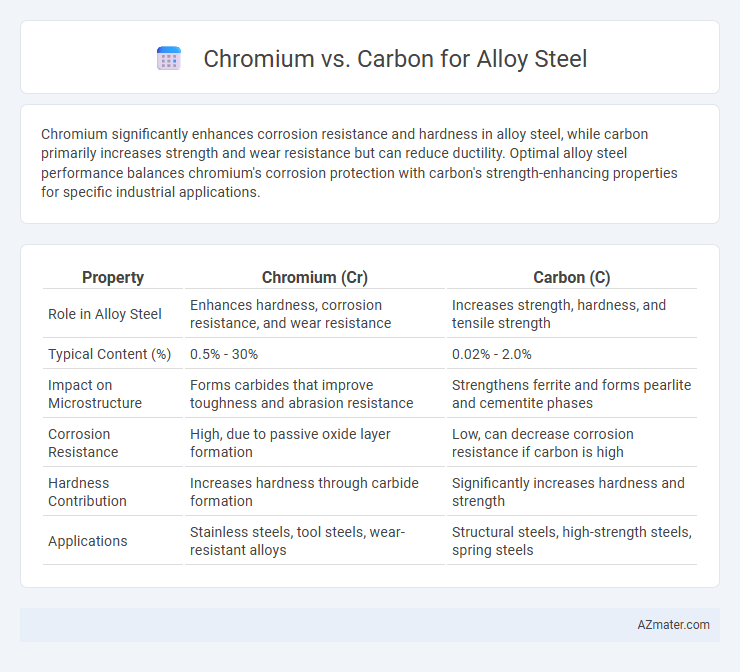Chromium significantly enhances corrosion resistance and hardness in alloy steel, while carbon primarily increases strength and wear resistance but can reduce ductility. Optimal alloy steel performance balances chromium's corrosion protection with carbon's strength-enhancing properties for specific industrial applications.
Table of Comparison
| Property | Chromium (Cr) | Carbon (C) |
|---|---|---|
| Role in Alloy Steel | Enhances hardness, corrosion resistance, and wear resistance | Increases strength, hardness, and tensile strength |
| Typical Content (%) | 0.5% - 30% | 0.02% - 2.0% |
| Impact on Microstructure | Forms carbides that improve toughness and abrasion resistance | Strengthens ferrite and forms pearlite and cementite phases |
| Corrosion Resistance | High, due to passive oxide layer formation | Low, can decrease corrosion resistance if carbon is high |
| Hardness Contribution | Increases hardness through carbide formation | Significantly increases hardness and strength |
| Applications | Stainless steels, tool steels, wear-resistant alloys | Structural steels, high-strength steels, spring steels |
Introduction to Alloy Steel Composition
Alloy steel composition primarily involves the addition of elements like chromium and carbon to enhance mechanical properties and corrosion resistance. Chromium increases hardness, tensile strength, and oxidation resistance, making it essential for stainless and heat-resistant steels. Carbon significantly affects hardness and strength but can reduce ductility; balancing carbon and chromium levels is critical to achieving desired performance characteristics in alloy steels.
Overview of Chromium and Its Role in Alloy Steel
Chromium is a critical alloying element in alloy steel, known for enhancing corrosion resistance, hardness, and strength by forming a stable oxide layer on the steel surface. Typically added in concentrations ranging from 0.5% to over 12%, chromium significantly improves wear resistance and high-temperature performance in steels such as stainless steel and tool steel. Its ability to increase hardness while maintaining toughness makes chromium indispensable in developing durable, corrosion-resistant alloy steel grades.
The Impact of Carbon Content in Alloy Steel
Carbon content significantly influences the hardness and strength of alloy steel, while chromium enhances corrosion resistance and wear properties. High carbon levels increase tensile strength and hardness but reduce ductility, making the steel more brittle, whereas chromium improves toughness and oxidation resistance. The optimal balance of carbon and chromium is crucial to achieving alloy steel with superior mechanical performance and durability.
Mechanical Properties: Chromium vs Carbon Alloys
Chromium significantly enhances the tensile strength, hardness, and wear resistance of alloy steel compared to carbon alone, by forming stable carbides and improving hardenability. Carbon increases hardness but can reduce ductility and toughness, while chromium balances strength with improved corrosion resistance and toughness. High-chromium alloy steels typically exhibit superior impact resistance and fatigue strength over high-carbon steels, making them ideal for demanding mechanical applications.
Corrosion Resistance: Contribution of Chromium and Carbon
Chromium significantly enhances corrosion resistance in alloy steel by forming a stable, passive oxide layer that protects the surface from oxidizing agents. Carbon, while improving hardness and strength, can reduce corrosion resistance by promoting the formation of chromium carbides, which deplete chromium at grain boundaries. Optimizing chromium content and controlling carbon levels are crucial for maintaining a balance between mechanical properties and corrosion resistance in alloy steel.
Hardness and Strength Enhancement Comparison
Chromium significantly enhances the hardness and tensile strength of alloy steel by forming strong carbides that improve wear resistance and maintain structural integrity under high stress. Carbon contributes to steel's hardness through the formation of iron carbides but can reduce toughness if present in excess, making its balance critical for optimal strength. The combined effect of chromium and carbon in alloy steel results in a superior microstructure that maximizes both hardness and strength, outperforming steels with higher carbon alone.
Wear Resistance: Chromium and Carbon Effects
Chromium significantly enhances the wear resistance of alloy steel by forming hard chromium carbides that increase surface hardness and reduce abrasion. Higher carbon content contributes to the formation of pearlite and carbides, improving strength and wear resistance but can decrease toughness if overly concentrated. Optimal wear resistance in alloy steel is achieved through a balanced combination of chromium for hardness and carbon for strength.
Weldability and Fabrication Considerations
Chromium in alloy steel significantly enhances weldability by reducing the risk of cracking through improved hardenability and corrosion resistance, making it favorable for fabrication processes involving high-temperature exposure. Carbon content affects weldability adversely by increasing hardness and brittleness, necessitating controlled heat input and preheating to prevent weld defects. Optimal alloying balances chromium to improve mechanical properties while maintaining carbon at levels that ensure manageable welding and fabrication conditions.
Common Applications of Chromium- and Carbon-Rich Alloy Steels
Chromium-rich alloy steels are widely used in automotive components, aerospace parts, and industrial machinery due to their superior corrosion resistance, wear resistance, and high-temperature strength. Carbon-rich alloy steels find common applications in structural components, cutting tools, and heavy-duty machine parts where high hardness and tensile strength are essential. Both types are integral in manufacturing pipelines, pressure vessels, and construction materials, with chromium alloys favored for environments requiring increased oxidation resistance.
Choosing the Right Alloy: Factors and Recommendations
Chromium enhances alloy steel's hardness, corrosion resistance, and high-temperature strength, making it ideal for environments requiring durability and oxidation resistance. Carbon increases strength and hardness through heat treatment but can reduce weldability and corrosion resistance if used excessively. Selecting the correct alloy depends on application-specific needs such as wear resistance, toughness, and environmental exposure; for high-strength and corrosion-resistant requirements, chromium-rich alloys are recommended, whereas carbon-focused alloys are preferred for cost-effective, high-hardness applications.

Infographic: Chromium vs Carbon for Alloy Steel
 azmater.com
azmater.com